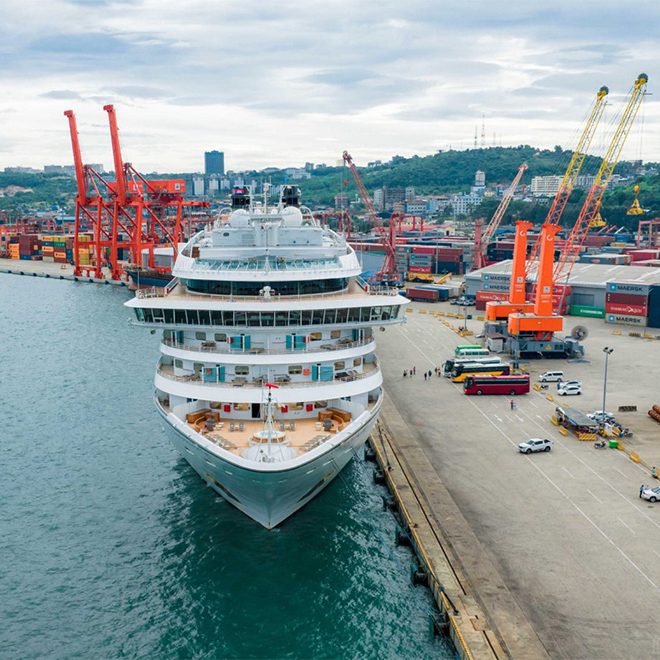
News
Clearing Borders, Connecting Economies: How Digital Partnerships Are Transforming Trade

At many of our borders, long queues, unpredictable delays and outdated procedures were once taken for granted. Fragmented institutions, limited access to shipment data, and dependence on manual paperwork made international trade more costly, less transparent and slower to respond to the needs of our economies.
For developing countries such as ours, seeking a stronger foothold in global markets, these inefficiencies posed serious obstacles to growth and competitiveness.
Today, as representatives of countries at the forefront of customs modernisation, we are witnessing a quieter yet powerful transformation, one driven not just by infrastructure, but by digital cooperation and institutional reform. Across regions and stages of development, governments are reimagining the way borders function. The shift is from isolated systems to integrated, data-enabled processes that support faster clearances, more accountable institutions and stronger resilience against the disruptions that increasingly define global trade.
In this context, our countries have engaged in technical cooperation with the UN Trade and Development (UNCTAD). Through its ASYCUDA Programme, UNCTAD has supported us in building and adapting digital platforms to improve customs performance and border governance.
Among the most impactful innovations is ASYHUB, a cloud-based system developed in partnership with the Shipping and Express logistics industries and the Universal Postal Union. ASYHUB facilitates the early exchange and processing of consignment data between customs administrations and external trade actors, offering a modular design that can be adapted to maritime cargo, express consignments, or postal flows, depending on national priorities.
In our countries, the benefits of this shift are increasingly visible. By enabling early access to shipment data, ASYHUB allows customs procedures to begin before cargo reaches the border, turning clearance from a reactive process into a proactive one. Where we once had to wait for goods to arrive before starting formalities, our customs officers can now conduct risk assessments, plan inspections and prepare releases in advance.
Cambodia illustrates this transformation well. Since adopting all three ASYHUB modules, the country has digitised key border operations. The deployment of ASYHUB Express in 2022 enabled real-time data exchange with courier companies, improving the clearance of low-value shipments. Between 2021 and 2023, trade transactions and customs revenue in Cambodia rose by 17 per cent. Pilots of the maritime module followed in 2024 at Sihanoukville and Phnom Penh ports, allowing pre-arrival processing of cargo manifests and enhancing risk targeting. The earlier integration of ASYHUB Postal, through the Universal Postal Union, expedited mail clearance and helped small businesses participate more actively in e-commerce.
In Sri Lanka, a broader modernisation agenda including the introduction of advance cargo processing, contributed to a nearly 57 per cent increase in customs revenue between 2023 and 2024. Faster clearances, better-targeted inspections and improved inter-agency coordination delivered measurable institutional gains.
Jordan’s experience underscores the transformative potential of pre-arrival date in driving smarter planning, more efficient inspections and a higher standard of institutional performance. As a country with a single maritime gateway, Jordan plays a pivotal role as both an import hub and a strategic corridor for regional transit, facilitating vital trade flows to Iraq, Syria, and the Palestinian territories. Its Red Sea access through the Port of Aqaba connects it to broader African and Asian trade routes, reinforcing the port’s relevance not only nationally but across the region.
In 2024, Jordan piloted ASYHUB Maritime to test the feasibility of advance cargo data processing and risk targeting. Building on the success of that pilot, the platform was officially launched at Aqaba’s passenger terminal in early 2025 and subsequently expanded to the container terminal in April 2025. The deployment marked a significant shift from post-arrival to pre-arrival clearance planning, enabling customs authorities to assess, prepare and manage shipments well before docking.
The implementation has already begun to yield operational dividends. Customs officials have reported a measurable decline in unnecessary physical inspections and greater precision in targeting high-risk consignments. In addition, inspection teams have been able to deploy resources more strategically, reducing bottlenecks and improving the overall flow of goods through the port. With plans now underway to extend ASYHUB’s application to express shipments, Jordan’s reform path reflects a growing institutional capacity to modernize border operations in line with international best practices, strengthening not only trade efficiency, but also national competitiveness and regional connectivity.
In Venezuela, we are seeing how digital tools can strengthen not only customs, but the broader system of border governance. ASYHUB Maritime is at the centre of one of the region’s most ambitious digital trade reforms, forming the backbone of a national Maritime Single Window. Spearheaded by the Maritime Authority (INEA) and the port operator BoliPuertos, the platform is transforming how port operations are coordinated and delivered.
Strategically located along the Caribbean coast, Venezuela is leveraging its proximity to the Panama Canal and major Gulf ports to position itself as a regional logistics hub.
Since ASYHUB’s rollout at La Guaira Port in March 2025, a previously fragmented system landscape has been replaced by a unified digital environment covering vessel registration, port call authorisations, cargo declarations and clearance documentation. Early results are encouraging. Agencies report faster processing, fewer duplications and greater operational coherence. Shipping agents and customs officials alike are experiencing quicker turnaround times, improved coordination and growing confidence in a system designed to modernise border operations and elevate Venezuela’s role in international trade.
Across all these examples, one clear principle emerges. Digital transformation in customs is not achieved through software alone. It requires embedding new tools into long-term institutional reforms, building skills, improving governance and aligning modernisation with national development strategies. In each of our countries, we have selectively adopted ASYHUB’s maritime, express or postal features based on our own needs, solving immediate challenges while building the foundations for more resilient systems.
At the same time, these reforms are helping us align more closely with international frameworks. Enhanced risk management, standardised documentation and interoperable systems are strengthening our compliance with global standards, including the World Customs Organization’s SAFE Framework of Standards, the International Maritime Organization’s Facilitation Convention and the Universal Postal Union’s digital trade initiatives.
The broader importance of these changes is increasingly clear. In a world where supply chain disruptions are no longer the exception but the norm, resilience at the border is essential. Transparent, efficient and digitally connected customs administrations are critical for ensuring that goods, services and essential supplies can move smoothly across borders, even in times of crisis. As climate change, geopolitical tensions and global health threats continue to reshape trade, our ability to innovate and adapt at the border will be central to our future competitiveness.
Perhaps most importantly, the progress we have seen across our countries reminds us of a fundamental truth. Successful digital reform is built not only on technology, but on leadership, coordination, and commitment. It depends on listening to the realities of those working on the ground, designing systems that solve real-world problems and building platforms that traders and citizens alike can trust.
As global trade grows in complexity, its future will be shaped not just by how goods move across borders, but by how well data, decisions and collaboration move with them. In this future, smart, inclusive and resilient customs administrations will be indispensable.
Through deliberate digital modernisation, grounded in national leadership and supported by effective international partnerships, our countries are taking meaningful steps to clear borders, connect economies and build a more secure, sustainable foundation for global trade.
Authored by

H.E. Mr. SUON Prasith
Ambassador and Permanent Representative of the Kingdom of Cambodia to the World Trade Organization (WTO) and other International Organizations in Geneva

H.E. Mr. Akram Sa’ud Harahsheh
Ambassador and Permanent Representative of the Hashemite Kingdom of Jordan to the United Nations Office and other International Organizations in Geneva

H.E. Mr. Alexander Gabriel Yánez Deleuze
Ambassador and Permanent Representative of the Bolivarian Republic of Venezuela to the United Nations Office and other International Organizations in Geneva
Originally published by the Phnom Penh Post .
At many of our borders, long queues, unpredictable delays and outdated procedures were once taken for granted. Fragmented institutions, limited access to shipment data, and dependence on manual paperwork made international trade more costly, less transparent and slower to respond to the needs of our economies.
For developing countries such as ours, seeking a stronger foothold in global markets, these inefficiencies posed serious obstacles to growth and competitiveness.
Today, as representatives of countries at the forefront of customs modernisation, we are witnessing a quieter yet powerful transformation, one driven not just by infrastructure, but by digital cooperation and institutional reform. Across regions and stages of development, governments are reimagining the way borders function. The shift is from isolated systems to integrated, data-enabled processes that support faster clearances, more accountable institutions and stronger resilience against the disruptions that increasingly define global trade.
In this context, our countries have engaged in technical cooperation with the UN Trade and Development (UNCTAD). Through its ASYCUDA Programme, UNCTAD has supported us in building and adapting digital platforms to improve customs performance and border governance.
Among the most impactful innovations is ASYHUB, a cloud-based system developed in partnership with the Shipping and Express logistics industries and the Universal Postal Union. ASYHUB facilitates the early exchange and processing of consignment data between customs administrations and external trade actors, offering a modular design that can be adapted to maritime cargo, express consignments, or postal flows, depending on national priorities.
In our countries, the benefits of this shift are increasingly visible. By enabling early access to shipment data, ASYHUB allows customs procedures to begin before cargo reaches the border, turning clearance from a reactive process into a proactive one. Where we once had to wait for goods to arrive before starting formalities, our customs officers can now conduct risk assessments, plan inspections and prepare releases in advance.
Cambodia illustrates this transformation well. Since adopting all three ASYHUB modules, the country has digitised key border operations. The deployment of ASYHUB Express in 2022 enabled real-time data exchange with courier companies, improving the clearance of low-value shipments. Between 2021 and 2023, trade transactions and customs revenue in Cambodia rose by 17 per cent. Pilots of the maritime module followed in 2024 at Sihanoukville and Phnom Penh ports, allowing pre-arrival processing of cargo manifests and enhancing risk targeting. The earlier integration of ASYHUB Postal, through the Universal Postal Union, expedited mail clearance and helped small businesses participate more actively in e-commerce.
In Sri Lanka, a broader modernisation agenda including the introduction of advance cargo processing, contributed to a nearly 57 per cent increase in customs revenue between 2023 and 2024. Faster clearances, better-targeted inspections and improved inter-agency coordination delivered measurable institutional gains.
Jordan’s experience underscores the transformative potential of pre-arrival date in driving smarter planning, more efficient inspections and a higher standard of institutional performance. As a country with a single maritime gateway, Jordan plays a pivotal role as both an import hub and a strategic corridor for regional transit, facilitating vital trade flows to Iraq, Syria, and the Palestinian territories. Its Red Sea access through the Port of Aqaba connects it to broader African and Asian trade routes, reinforcing the port’s relevance not only nationally but across the region.
In 2024, Jordan piloted ASYHUB Maritime to test the feasibility of advance cargo data processing and risk targeting. Building on the success of that pilot, the platform was officially launched at Aqaba’s passenger terminal in early 2025 and subsequently expanded to the container terminal in April 2025. The deployment marked a significant shift from post-arrival to pre-arrival clearance planning, enabling customs authorities to assess, prepare and manage shipments well before docking.
The implementation has already begun to yield operational dividends. Customs officials have reported a measurable decline in unnecessary physical inspections and greater precision in targeting high-risk consignments. In addition, inspection teams have been able to deploy resources more strategically, reducing bottlenecks and improving the overall flow of goods through the port. With plans now underway to extend ASYHUB’s application to express shipments, Jordan’s reform path reflects a growing institutional capacity to modernize border operations in line with international best practices, strengthening not only trade efficiency, but also national competitiveness and regional connectivity.
In Venezuela, we are seeing how digital tools can strengthen not only customs, but the broader system of border governance. ASYHUB Maritime is at the centre of one of the region’s most ambitious digital trade reforms, forming the backbone of a national Maritime Single Window. Spearheaded by the Maritime Authority (INEA) and the port operator BoliPuertos, the platform is transforming how port operations are coordinated and delivered.
Strategically located along the Caribbean coast, Venezuela is leveraging its proximity to the Panama Canal and major Gulf ports to position itself as a regional logistics hub.
Since ASYHUB’s rollout at La Guaira Port in March 2025, a previously fragmented system landscape has been replaced by a unified digital environment covering vessel registration, port call authorisations, cargo declarations and clearance documentation. Early results are encouraging. Agencies report faster processing, fewer duplications and greater operational coherence. Shipping agents and customs officials alike are experiencing quicker turnaround times, improved coordination and growing confidence in a system designed to modernise border operations and elevate Venezuela’s role in international trade.
Across all these examples, one clear principle emerges. Digital transformation in customs is not achieved through software alone. It requires embedding new tools into long-term institutional reforms, building skills, improving governance and aligning modernisation with national development strategies. In each of our countries, we have selectively adopted ASYHUB’s maritime, express or postal features based on our own needs, solving immediate challenges while building the foundations for more resilient systems.
At the same time, these reforms are helping us align more closely with international frameworks. Enhanced risk management, standardised documentation and interoperable systems are strengthening our compliance with global standards, including the World Customs Organization’s SAFE Framework of Standards, the International Maritime Organization’s Facilitation Convention and the Universal Postal Union’s digital trade initiatives.
The broader importance of these changes is increasingly clear. In a world where supply chain disruptions are no longer the exception but the norm, resilience at the border is essential. Transparent, efficient and digitally connected customs administrations are critical for ensuring that goods, services and essential supplies can move smoothly across borders, even in times of crisis. As climate change, geopolitical tensions and global health threats continue to reshape trade, our ability to innovate and adapt at the border will be central to our future competitiveness.
Perhaps most importantly, the progress we have seen across our countries reminds us of a fundamental truth. Successful digital reform is built not only on technology, but on leadership, coordination, and commitment. It depends on listening to the realities of those working on the ground, designing systems that solve real-world problems and building platforms that traders and citizens alike can trust.
As global trade grows in complexity, its future will be shaped not just by how goods move across borders, but by how well data, decisions and collaboration move with them. In this future, smart, inclusive and resilient customs administrations will be indispensable.
Through deliberate digital modernisation, grounded in national leadership and supported by effective international partnerships, our countries are taking meaningful steps to clear borders, connect economies and build a more secure, sustainable foundation for global trade.
Authored by

H.E. Mr. SUON Prasith
Ambassador and Permanent Representative of the Kingdom of Cambodia to the World Trade Organization (WTO) and other International Organizations in Geneva

H.E. Mr. Akram Sa’ud Harahsheh
Ambassador and Permanent Representative of the Hashemite Kingdom of Jordan to the United Nations Office and other International Organizations in Geneva

H.E. Mr. Alexander Gabriel Yánez Deleuze
Ambassador and Permanent Representative of the Bolivarian Republic of Venezuela to the United Nations Office and other International Organizations in Geneva
Originally published by the Phnom Penh Post .



